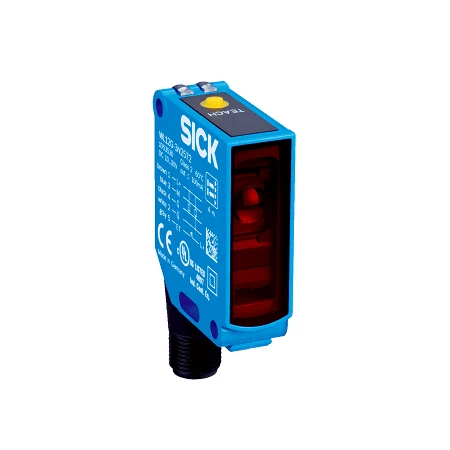
$ 299.92
SICK sensor one of the world’s leading producers of sensors and sensor solutions for industrial applications. SICK is a technology and market leader in Factory and Logistics Automation as well as Process Automation. The sensor range are: Laser Sensors, Cylinder Sensors, Photoelectric Sensors, Fork Sensors, Encoders, Color Sensors, Distance Sensor, Contrast Sensor, Color Sensor, Inductive Proximity Sensors, Fiber Optic Sensor with our signature range sick sensor intelligence.
Part Number:1070335
Photoelectric Sensor Model:WL12GC-3P2472B01
| Device type | Photoelectric sensors |
| Sensor/ detection principle | Photoelectric retro-reflective sensor, autocollimation |
| Dimensions (W x H x D) | 15.6 mm x 48.5 mm x 42 mm |
| Housing design (light emission) | Rectangular |
| Sensing range max. | 0 m … 4 m |
| Sensing range | 0 m … 4 m 1) |
| Type of light | Visible red light |
| Light source | PinPoint LED 2) |
| Light spot size (distance) | Ø 25 mm (1.5 m) |
| Wave length | 660 nm |
| Adjustment | IO-Link Single teach-in button |
| Pin 2 configuration | External input, Teach-in input, Sender off input, Detection output, logic output, Device contamination alarm output |
| AutoAdapt | ✔ |
| Special applications | Detecting transparent objects |
| Special features | Functions compatible with WL12GC-3P2472A91 |
| Supply voltage | 10 V DC … 30 V DC 1) |
| Ripple | < 5 Vpp 2) |
| Current consumption | 30 mA 3) |
| Switching output | PNP |
| Switching mode | Light/dark switching |
| Signal voltage PNP HIGH/LOW | Approx. VS – 2.5 V / 0 V |
| Output current Imax. | ≤ 100 mA |
| Response time Q/ on Pin 2 | 200 µs … 300 µs 4) 5) |
| Switching frequency | 1,500 Hz 6) |
| Switching frequency Q / to pin 2 | ≤ 1,500 Hz 7) |
| Attenuation along light beam | > 8 % |
| Connection type | Male connector M12, 4-pin |
| Circuit protection | A 8)
B 9) C 10) D 11) |
| Protection class | III |
| Weight | 120 g |
| Polarisation filter | ✔ |
| Housing material | Metal, zinc diecast |
| Optics material | Plastic, PMMA |
| Enclosure rating | IP66 IP67 |
| Special feature | Detecting transparent objects |
| Ambient operating temperature | –40 °C … +60 °C |
| Ambient temperature, storage | –40 °C … +75 °C |
| UL File No. | NRKH.E181493 & NRKH7.E181493 |
| Repeatability Q/ on Pin 2: | 100 µs 5) |
| Communication interface | IO-Link V1.1 |
| Communication Interface detail | COM2 (38,4 kBaud) |
| Cycle time | 2.3 ms |
| Process data length | 16 Bit |
| Process data structure | Bit 0 = switching signal QL1 Bit 1 = switching signal QL2 Bit 2 … 15 = measuring value |
| VendorID | 26 |
| DeviceID HEX | 0x8000F5 |
| DeviceID DEC | 8388853 |
| Smart Task name | Timestamp + debouncing | ||||||
| Logic function | Direct AND OR WINDOW Hysteresis |
||||||
| Timer function | Deactivated On delay Off delay ON and OFF delay Impulse (one shot) |
||||||
| Inverter | Yes | ||||||
| Response time | SIO Direct: 300 µs … 450 µs 1) SIO Logic: 550 µs … 650 µs 2) IOL: — 3) |
||||||
| Time stamp accuracy | SIO Direct: — SIO Logic: — IOL: – 90 … + 90 µs |
||||||
| SIO Direct: 150 µs 1) SIO Logic: 150 µs 2) IOL: — 3) |
|||||||
| Min. Time between two process events (switches) | SIO Direct: 450 µs SIO Logic: 450 µs IOL: 500 ms |
||||||
| Time stamp number buffer | SIO Direct: — SIO Logic: — IOL: 8 |
||||||
| Max. TimeStamp Range | SIO Direct: — SIO Logic: — IOL: 260 ms |
||||||
| Debounce time max. | SIO Direct: — SIO Logic: 52 ms IOL: 52 ms |
||||||
|
|||||||
| Measuring value | Timestamp | ||||||